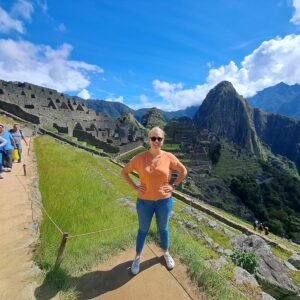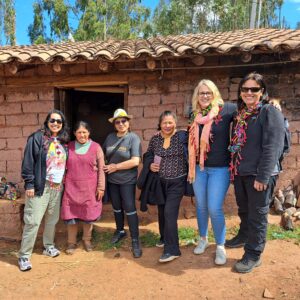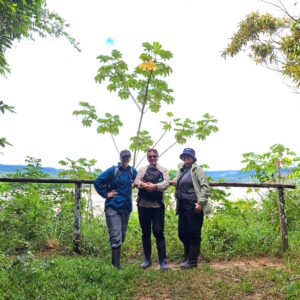Discover Peru: Unforgettable Adventures Await

When I tell people how much I love my job, they usually don’t get it— until I mention that I’m heading to Peru for a project visit! Suddenly, everyone’s all ears.
Sure, site visits aren’t an everyday thing (most of our travel is for study tours), but they’re a crucial part of what we do. They let us reconnect with our awesome onsite teams, experience the student life firsthand, and ensure everything’s running smoothly. On my latest trip in May 2024, I got to do all that and more—showcasing our two incredible Peru programs to staff from Deakin University!
Peru boasts 90 distinct microclimates and encompasses 30 of the world’s 32 climate types. The country’s diverse geography ranges from sea level to 6,700 m above sea level, featuring coastlines, highlands, and rainforests. I’ll be honest, I was naive to Peru’s environmental diversity. Arriving into Cusco (3400m above sea level) I was taken back at how dry and almost treeless the environment is up in the Andes. But at that altitude the air is thinner, and given I struggled to take the one flight of stairs to my hotel room, I now understand.
Our two volunteer programs in Peru begin in Cusco, a charming mountain city rich in history from its time as the capital of the Inca Empire. Now the gateway to Machu Picchu and the Peruvian Amazon Rainforest, tourism is Cusco’s main industry. The people are friendly, and I felt safe in the city centre even after sunset.
 Our Community Development & Environmental Change Program is based in and around Cusco. In pairs, students are allocated to homestay families located close to the city centre. They sleep and share breakfast and dinner with their homestay families. This provides an excellent opportunity for students to develop spanish language skills and gain a deeper understanding of the culture. During the day they travel out to the Sacred Valley where they work on projects located in rural villages. These projects are providing much needed support to these poor farming families, including the construction of greener burning woodfire stoves, ecological refrigerators and cupboards and sustainable greenhouses. I felt truly humbled by the day we spent in these communities. Life is simple and they work very hard as a community to provide for their families. This short video includes some footage and interviews to highlight the impact our students have on these communities. Due to the impact of COVID-19 and a subsequent year of political instability, these communities received little to no assistance for over four years. With Peru now enjoying a stable political environment, my visit here has really highlighted the importance of these programs for these communities.
Our Community Development & Environmental Change Program is based in and around Cusco. In pairs, students are allocated to homestay families located close to the city centre. They sleep and share breakfast and dinner with their homestay families. This provides an excellent opportunity for students to develop spanish language skills and gain a deeper understanding of the culture. During the day they travel out to the Sacred Valley where they work on projects located in rural villages. These projects are providing much needed support to these poor farming families, including the construction of greener burning woodfire stoves, ecological refrigerators and cupboards and sustainable greenhouses. I felt truly humbled by the day we spent in these communities. Life is simple and they work very hard as a community to provide for their families. This short video includes some footage and interviews to highlight the impact our students have on these communities. Due to the impact of COVID-19 and a subsequent year of political instability, these communities received little to no assistance for over four years. With Peru now enjoying a stable political environment, my visit here has really highlighted the importance of these programs for these communities.
 The second program in Peru is our Rainforest Environmental Conservation Program. The students begin their program with 2 nights in Cusco. A detailed orientation session prepares them for their 4 week adventure into the Amazon Rainforest. It takes 10-12 hours to reach the project site located in the Manu National Park Buffer Zone. This journey is broken up over two days with the group staying at a rural homestay in the Cloud Forest before travelling the last few hours down to meet the boat the following morning. The project site is only reachable by boat along the river. Arriving at a set of handmade stairs leading into the rainforest is all that is evident of the project site from the river. After disembarking and climbing a decent set of stairs (now possible at 500m above sea level) the rainforest opens out into a small clearing that is home to the project base. The eco-lodge is simple, but comfortable. Students spend 4 weeks here and will become accustomed to the 2 hours of electricity each day, limited WiFi, mostly cold showers, the humidity and MUD!
The second program in Peru is our Rainforest Environmental Conservation Program. The students begin their program with 2 nights in Cusco. A detailed orientation session prepares them for their 4 week adventure into the Amazon Rainforest. It takes 10-12 hours to reach the project site located in the Manu National Park Buffer Zone. This journey is broken up over two days with the group staying at a rural homestay in the Cloud Forest before travelling the last few hours down to meet the boat the following morning. The project site is only reachable by boat along the river. Arriving at a set of handmade stairs leading into the rainforest is all that is evident of the project site from the river. After disembarking and climbing a decent set of stairs (now possible at 500m above sea level) the rainforest opens out into a small clearing that is home to the project base. The eco-lodge is simple, but comfortable. Students spend 4 weeks here and will become accustomed to the 2 hours of electricity each day, limited WiFi, mostly cold showers, the humidity and MUD!
This project site encompasses a 640 hectare reserve, within the cultural zone of the Manu Biosphere Reserve, a UNESCO World Heritage site and the largest protected area in Peru. The reserve is a secondary forest. It was once farmland and had been selectively logged and in some areas completely destroyed for growing crops and grazing cattle. It has been regenerating for 30 to 50 years and strictly protected for just over two decades, it now houses 87% of the biodiversity that’s found in primary forests. Students spend their days in the forest learning from a team of biology and conservation experts, conducting research, and assisting in the conservation and education of local communities. This short video is a snapshot of our time in the Amazon Rainforest.
As someone without a science background, the three days I spent on this project were truly inspirational. It’s a unique and delicate place in the world. Participating in this program offers students from any background the chance to develop a profound respect for conservation and the environment, not to mention the valuable life skills acquired from living “almost” off-grid for four weeks.
I am truly humbled by my visit to both project sites. The opportunities that these programs create have a lasting impact on the lives of both our students and the local communities. I look forward to working with students to facilitate these programs.
Senior Manager, University Relations and Business Development
May 2024
